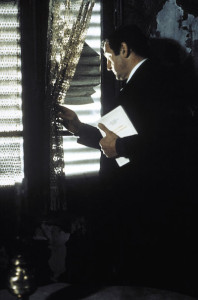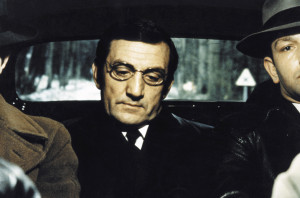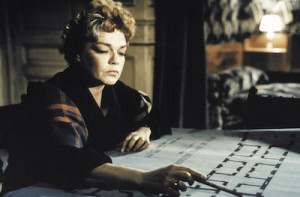ARMY OF SHADOWS WWII Film – A Must-See
The Rialto film, Jean-Pierre Melville’s Army of Shadows, plays for a one-week engagement (November 20-26) at the Ahrya Fine Arts Theater in Beverly Hills. The new DCP restoration of the director’s masterpiece is a “must-see.” Philippe (Lino Ventura), aided by Resistance compatriots including the mistress of disguise Mathilde (Simone Signoret), goes underground in the face of the German Occupation.
Watch the harrowing trailer here. (https://www.youtube.com/watch?v=GYl2I0vVok4)
Lino Ventura in Army of Shadows. Photo courtesy Rialto Pictures
The opening shot alone pulls you into the film and holds you in its grip. There is a bleak, grey sky and the Arc de Triomphe. Marching music begins. At the same time, in the very bottom right corner of the screen, your eye is drawn to a flicker. The flicker slowly, boldly grows into a longer and longer line of German troops. They goose-step toward and onto the Champs-Elyseess until they dominate the frame. It is one of the shots Melville was proudest of in the film. To make it he had to win an exemption from a law that prohibited German uniforms on the boulevard.
Army of Shadows continue to depict moments of ordinary life growing so much more significant in the bigger life and death situation. So the images and movements that begin almost imperceptibly, grow until they fill the screen with stunning impact. With minimal dialogue and only about eight to ten sequences in the entire film, many of them are played in real time, the film has aptly been described as being “about a state of mind,”more than war action.
The film follows the treacherous lives of a small cell of Resistance fighters based in Lyons and Paris. Their “army” is comprised of “shadows,” with members owning no real names, addresses or trust. They know they will probably die.
During World War II, France officially permitted the Nazi occupation in trade for avoiding open German warfare. Most of the citizens accepted it; the Resistance defied it. General Charles DeGaulle operated this Free French movement from London with his “army of shadows, “ ordinary citizens in street clothes clothes supposedly leading regular lives while they spied on the Germans, providing information and at times guerrilla raids.
Lino Ventura in Army of Shadows. ÊPhoto courtesy Rialto Pictures
Most cel members have never met their leader, a philosopher named Luc Jardie (Paul Meurisse). Their immediate commander is Philippe Gerbier (the granite-faced Lino Ventura). Mathilde, a “mistress of disguise,” played by Simone Signorot, works with him, along with comrades known as Francois (Jean-Pierre Cassel, Le Masque (Claude Mann and Felix (Paul Crochet.) Simone Signoret’s strong, resigned walk makes her as recognizable from behind as DeNiro.
Characters are drawn in both small and large moments. It would be expected that being caught up in a group arrest in a restaurant by police, just before he is caught, Gerbier swallows a piece of paper with incriminating names on it. When he joins cel members in prison and shares his pack of cigarettes in jail, there are none left for him. He simply nods. But in a more dramatic and equally telling moment shortly afterward, when the prisoners are given the choice to run down a corridor while Germans train machine guns on them or be shot on the spot, he hesitates until it is almost too late.
It is obvious from Army of Shadows why Melville became recognized as the early father of the New Wave. The director used actual locations, dolly shots with a camera mounted on a bicycle, unknown actors and unrehearsed street scenes, everyday incidents instead of building an dramatic arc. There are moments when the screen is black. There are moments when there is silence. They are welcome relief to the intensity.
Simone Signoret in Army of Shadows. Photo courtesy Rialto Pictures
Acting their own truth is the only reward of the Resistance members and no one comes out alive from the comrade we follow. Because many die under false names, their sacrifices are never known; in the film, two brothers never discover that they are both in the Resistance, and one dies anonymously.
There are a few lighter moments. The luxurious grounds of a Baron (Jean-Marie Robain), and the short-lived estate becomes the location for exchanging personnel and instructions. Gerbier and Jardie are taken to London for a brief ceremony with DeGaulle and an ironic Gone with the Wind screening.
Army of Shadows was saved twice from extinction. First it was banned in France when it was released in 1969 because in the wake of the May, 1968 social revolution, it was denounced by left-wing Parisian critics as “Gaullist.”
However, as soon as the first restored 35 mm print of Army of Shadows was shown in art theatres around the world in 1969, the restored 37-year- old film drew accolades. “A masterpiece,” Manola Darghis wrote in the NY Times, filled with “Melville’s world of broad shoulders and heavy burdens, shaved and grizzled faces, the civilized and the savage.” Roger Ebert raved, “Jean-Pierre Melville’s Army of Shadows is about members of the French Resistance who persist in the face of despair. As one of his films after another is rediscovered, Melville is moving into the ranks of the greatest directors.. (although) he was not much honored in his lifetime.”
Melville worked long and hard to adapt the film from Joseph Kessel’s short novel, “Army of Shadows,” considered the definitive book about the resistance (Kessel also wrote, “Belle de Jour!”) Why? In 1940, Melville reported, the Resistance in all numbered only 600. Many of them died under torture, including Jean Moulin, the original Luc Jardie. Kessel: “Since he was no longer able to speak, one of the Gestapo chiefs, Klaus Barbie, handed him a piece of paper on which he had written, ‘Are you Jean Moulins?’ Jean Moulin’s only reply was to take the pencil from Colonel Barbie and cross out the ‘s’.”
Ahrya Fine Arts Theater, 8556 Wilshire Blvd, Beverly Hills, CA 90211 (310) 659-9171, http://www.laemmle.com/theaters/25
Directed by Jean-Pierre Melville; written (in French, with English subtitles) by Melville, based on the novel by Joseph Kessel; director of photography, Pierre Lhomme; edited by Françoise Bonnot; music by Éric de Marsan; art director, Théobald Meurisse; produced by Jacques Dorfmann; released by Rialto Pictures.





